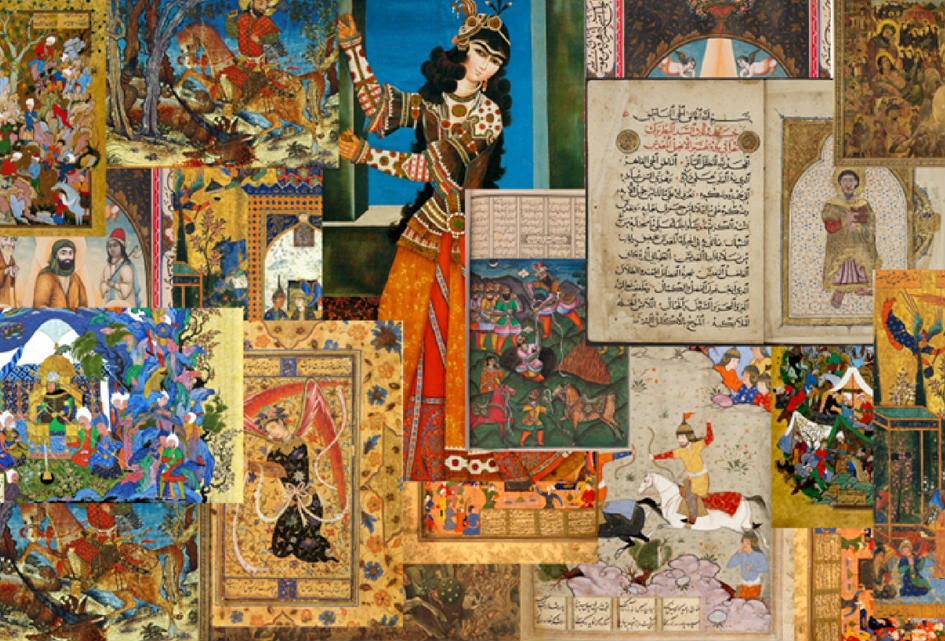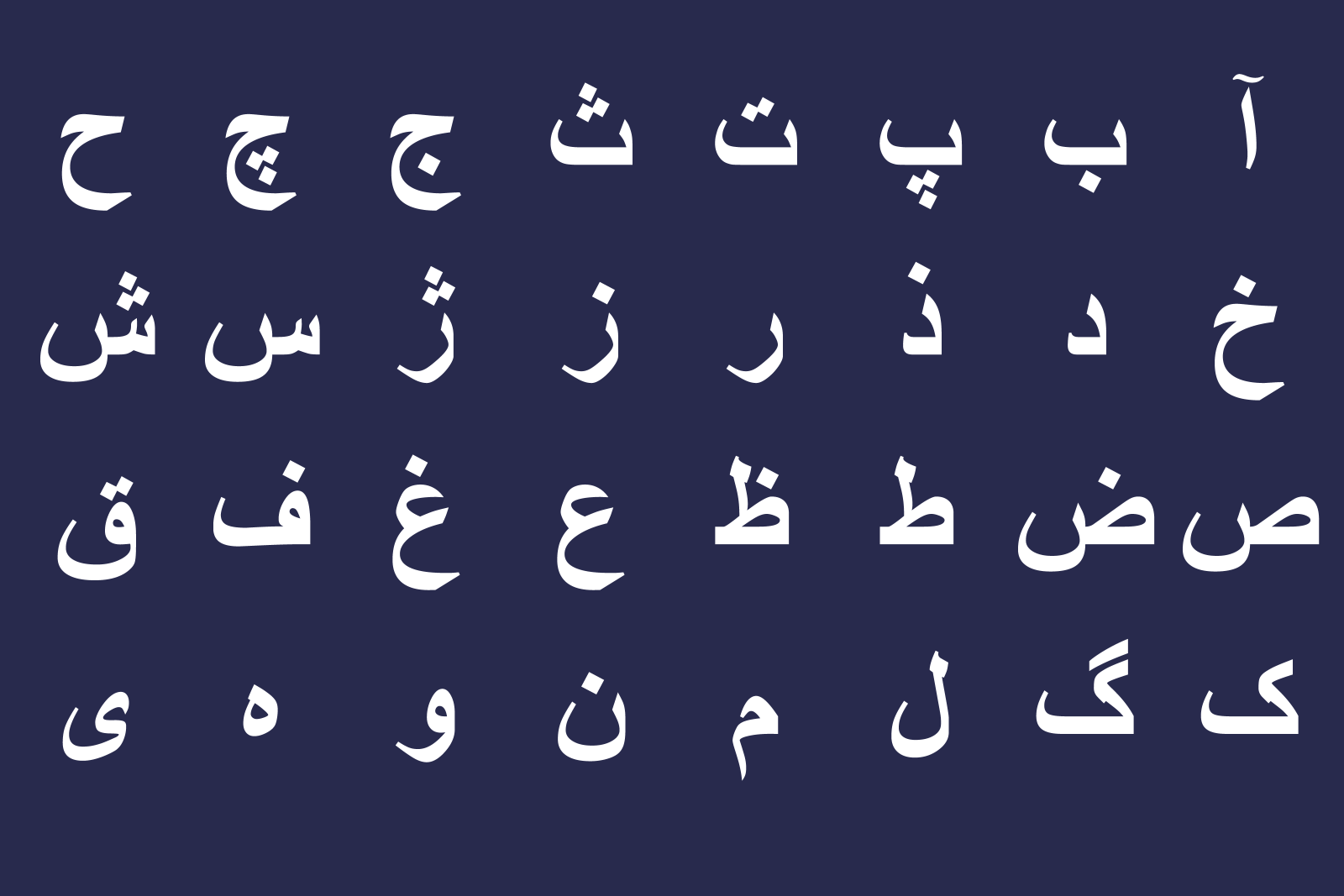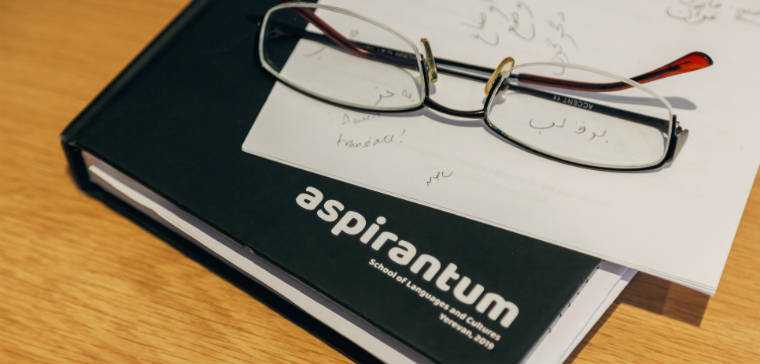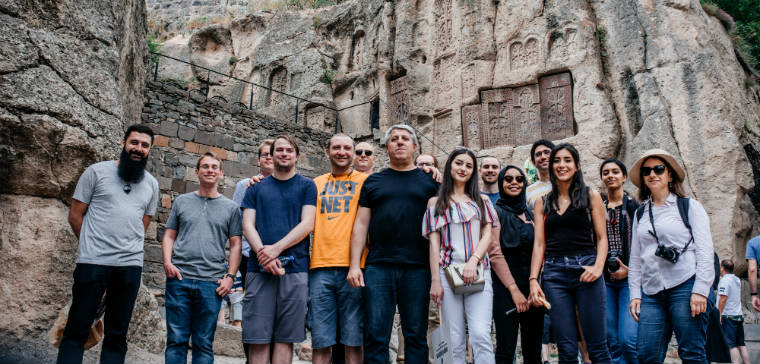Iran (or as it is also known as Persia) is a vast country, stretching from the Caspian Sea to the Persian Gulf and as such it is a country that enjoys all four seasons due to its geographic area. The counties at the shore of the two seas, as well as different cities depending on their geographical location, cultures and traditions, and natural resources have enjoyed different cuisines. For instance, even though cities adjoining both the Caspian Sea and the Persian Gulf are close to the seas, but because of the temperature differences between the north and the south, their eating habits are different. The food of the northern cities of Iran are mostly sweet, filled with fresh herbs and fruits like pomegranate and cherries, while in the south the foods are much more spicy and sour. However, there are some spices that are common in almost every Persian dish, for instance Saffron is a famous ingredient that has a special place in Persian kitchens. Turmeric, dried lime, mixed spices, rose water, and black pepper are the favourites among chefs and housewives. But the quantity and the way these spices are used in each city differs considerably.
Persian eating habits also differ from city to city. However, there are some desserts and appetizers that are almost the same in every household. For instance, Persians love consuming fresh herbs called Sabzi Khordan ‘سبزی خوردن’ which contains herbs like mint ‘نعناع’, basil ‘ریحان’, radish ‘تربچه’, parsley ‘جعفری’ leaves amongst others. These herbs are always accompanied with walnut and Persian feta cheese, and sometimes freshly baked flat bread. Also, Persians like having salads as appetizers or as a side dish with their food. Salad Shirazi ‘سالاد شیرازی’ is definitely the favourite of the country. There is also another famous appetizer or side dish called Mast o Mosir ‘ماست و موسیر’, which is made of thick yogurt (equivalent to Greek yogurt) and dried Persian shallots soaked in the yogurt for 2-3 days before serving. Limes and lemons, mixed pickles and soft drinks with some dishes are a must, however a healthier drink called Dough ‘دوغ’, which is a yoghurt based drink that can also be carbonated, is also a favourite amongst nutritionists.
This article will introduce two appetizers or side dishes, twelve of the most famous main dishes of Persia and a very interesting southern dessert. We will start with foods that are favoured in northern cities and then move south to the capital of Iran, Tehran, and finally to the southern counties most famously known through the oil producing city of Abadan, showing how the eating habits of different cities vary based on their geographic and cultural norms.
The Side Dishes and Appetizers
These side dishes are very famous amongst Persians, however, one needs to keep in mind that some of these are only consumed with dishes that are served with rice. For instance, no one eats Kale Pache ‘کله پاچه’ with Mast o Mosir ‘ماست و موسیر’, as the combination does not result to a tasty meal. On the other hand, Sabzi Khordan ‘سبزی خوردن’ can be consumed with anything, and there are older generations who like to have fresh herbs even with their fried eggs in the morning. Therefore, it is suggested to follow the restaurant serving services for those who are new to Persian cuisine, or ask the hosts if they can have certain side dishes or appetizers with the main dishes.
Salad Shirazi (سالاد شیرازی)

Based on its name, this appetizer comes from the city Shiraz and is considered as a side dish as well as an appetizer. It is fairly easy to make, and goes along with almost every Persian dish.
Preparation time: 10 mins
Ingredients:
· 1 kg cucumber (خیار۱ کیلو)
· Half kg tomatoes (نیم کیلو گوجه)
· 2 red onions (دو عدد پیاز)
· Salt and pepper to taste (نمک و فلفل به میزان لازم)
· Freshly squeezed juice of 2 Limes (آب لیموی تازه به میزان لازم)
· 1 tbsp dried mint (۱ قاشق غذاخوری نعنای خشک)
Wash and dry the cucumbers and tomatoes. Peel the onions and set aside. Finely chop all the ingredients in a bowl, add salt, pepper and lemon juice. Sprinkle dried mint and serve.
Mast o Mosir (ماست و موسیر) or Mast o Khiar (ماست و خیار)
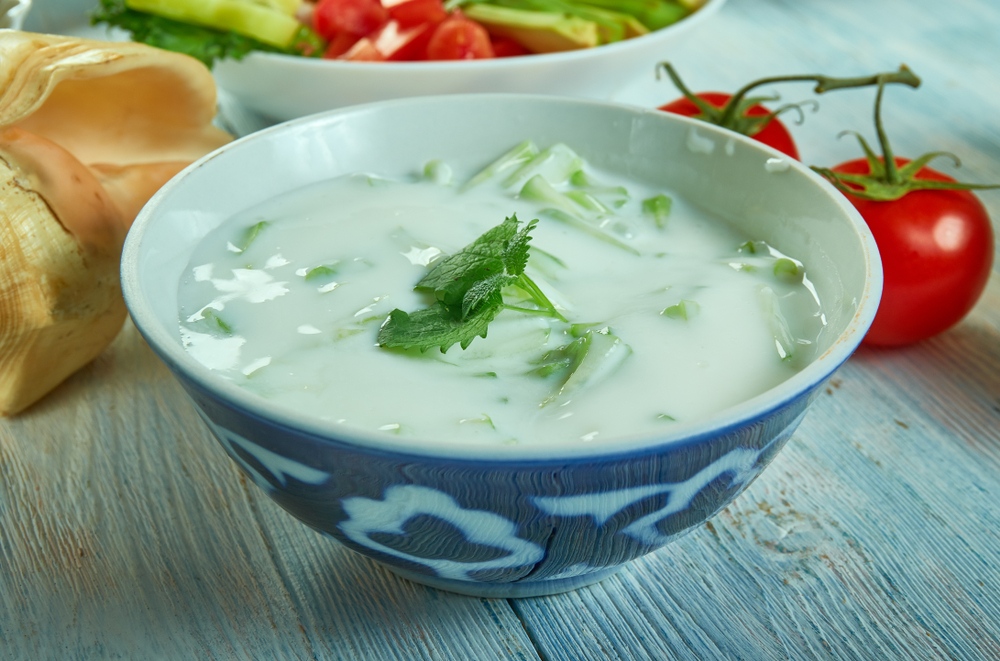
Mast o Mosir or Mast o Khiar is one of the most favorite side dishes or appetizers in Persian cuisine. It is fairly easy to prepare.
Preparation time: 15 mins
Ingredients:
· 1 kg Persian Thick yoghurt or Greek yogurt (۱ کیلو ماست چکیده)
· For Mast o Mosir 50 gr dried Persian shallots or (۵۰ گرم موسیر خشک)
· 4 small cucumbers for Mast o Khiar (۴ خیار کوچک برای ماست و خیار)
· Salt and pepper to taste (نمک و فلفل به میزان لازم)
· 2 cloves of garlic (Mast o Khiar) (دو حبه سیر برای ماست و خیار)
· 1 tbsp dried mint (Mast o Khiar) (۱ قاشق غذاخوری نعنا خشک)
Mix the dried shallot, salt and pepper with yogurt and keep in fridge for at least 2 days before serving. For Mast o Khiar, grate the cucumbers and mix the ingredients along with garlic and some dried mint to decorate. This side dish also goes with almost any rice based dish.
Main dishes
In Iran, most of the main dishes are served with steamed rice but not in its western sense. Persians boil salted water and cook the rice until it is half way done, then drain it and pour the rice in a pot and cover the lid with a clean cloth in order to steam the rice. The base of the rice is covered with various vegetables and is one of the most important parts of the main dish. The bottom part called Tah Dig ‘ته دیگ’ literally ‘the base of the pan’ could be covered with lettuce, sliced potatoes, sliced onions, or a mixture of rice, yogurt and egg yolk to get a crunchy layer of rice at the bottom that tastes entirely different from the steamed rice. In older days, when the weddings used to be celebrated at homes, one of the most important work attributes of the cook would be how he or she can make enough Tah Dig ‘ته دیگ’for every guest to have a piece dipped in the stew, soft on the inside but with a crunchy crust on the outside.
Mirza Ghasemi (میرزا قاسمی) ‘Egg plant, tomatoes and egg fry’
It is believed that this dish was named after the ruler of Rasht city Mirza Ghasemi ‘Lord Ghasemi’ in the north of Iran, during the time of Naser al-Din Shah Qajar around 200 years ago. It is a delicious dish, made with simple ingredients but normally not consumed with Mast o Khiar or Salad Shirazi.
Ingredients:
· ¼ cup vegetable oil (۱/۴ پیمانه روغن مایع)
· 4 big egg plants (۴ عدد بادمجان بزرگ)
· 6 big Tomatoes, grated (۶ عدد گوجه بزرگ رنده شده)
· 4 Eggs (۴ عدد تخم مرغ)
· 2 onions, chopped (۲ عدد پیاز نگینی)
· 1 head garlic, finely chopped (۱ کله سیر نگینی)
· salt and other spices to taste (نمک و ادویه به میزان لازم)
Preparation time: 45-60 mins
Preparation:
Step one: Put the eggplants on a woodfire or in an oven to smoke them and char the skin. When fully cooked, the skins are removed by placing the eggplants in ice cold water or simply covering them and allowing the skin to loosen because of the steam.
Step two: In a big frying pan, fry onions and garlic until transparent and then add the smoked egg plants and fry until all the water evaporates.
Step three: add the grated tomatoes to the mixture of egg plants and fried onion and garlic. Fry for around fifteen minutes and add turmeric, black pepper, paprika, and salt.
Step four: Add eggs and mix it well on low heat until the eggs are cooked which normally takes about 5 to 7 minutes.
This dish is then served with freshly baked Persian flat bread and fresh herbs like mint, basil, radish, and parsley.
Khoresh Fesenjaan (خورش فسنجان) ‘Chicken or lamb stew’

Fesenjaan is another authentic northern dish that is famous amongst Persians which dates back to almost two thousand years ago. This dish’s main ingredient is walnut; however, it also contains pomegranate paste or molasses, and based on the cook’s style and the regional prefernces, it can be sour or sweet. Khorsh Fesenjaan is considered a luxurious dish and is prepared on special occasions mostly during the last month of winter and during the festive season of the Persian new year which is around 20th March every year. The authentic Gilani Fesenjaan is prepared with goose, duck, and turkey meat, however in cheaper versions chicken is used to cook this dish. The colour of the stew varies between dark brown to almost black due to the use of walnut and pomegranate paste.
Preparation time: 30 mins
Cooking time: 3 hours
Total time: 3 hours and 30 mins
Ingredients:
· 1 kg of Poultry (chicken, duck, goose, turkey) ()
· 400 gr walnut, finely grated (۴۰۰ گرم گردو چرخ شده)
· 1 onion, finely chopped (۱ عدد پیاز نگینی)
· 5 ts pomegranate paste (۵ قاشق غذاخوری رب انار)
· 2-3 tsp sugar (۲-۳ قاشق غذاخوری شکر)
· Salt, black pepper, mixed spices, turmeric to taste (نمک، فلفل، ادویه، زردچوبه به میزان لازم)
· 4 cups of cold water (۴ پیمانه آب سرد)
Preparation:
Step one: Pour water on grated walnut and simmer for about 1 hour or until the oil separates. Make sure that the water used to simmer the walnuts must be cold, and if needed, more water can be added during this time.
Step two: In a separate pan, fry the poultry with salt, black pepper, turmeric and mixed spices. Turn the heat down and cover and allow the meat to cook for about 15 mins or until half cooked.
Step three: Once the walnut is cooked mix the pomegranate paste, the meat, sugar, and salt with the cooked walnut. Turn the heat down and cook for another 2 hours until the stew is not watery anymore and the walnut oil has completely separated from the ingredients.
This stew does not require lots of cooking oil as the walnut will satisfy this requirement. Once ready Fesenjaan is served with rice, preferably Persian Jasmine rice.
Koofteh Tabrizi (کوفته تبریزی)
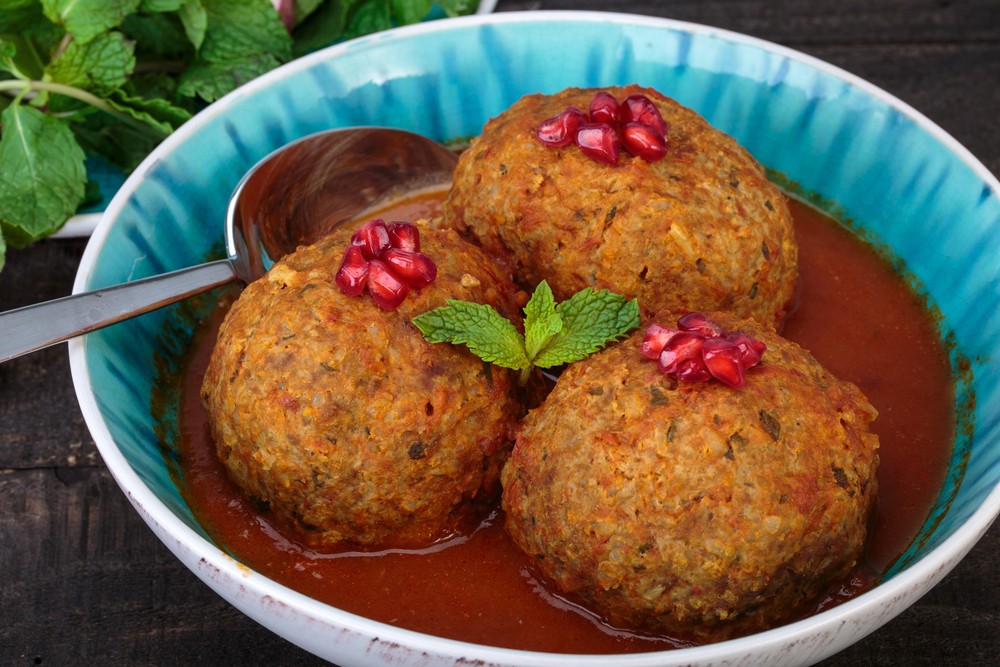
Moving to the famous city of Tabriz in north-west of Iran, which used to be the capital city of the country several times during modern history. Koofteh Tabrizi is a delicious dish in which aromatic herbs are used among other ingredients such as minced meat, yellow split peas, rice and eggs, walnuts or dried plums are used as the fillings. To make this dish more aromatic, tomato paste and saffron are also used. Sabzi Khordan is a must as a side dish with Koofteh Tabrizi.
Preparation time: 15-30 mins
Cooking time: 90-120 mins
Total time: 2-2:30 hours
Ingredients for the Koofteh:
· 500 grs minced meet (۵۰۰ گرم گوشت چرخ کرده)
· 250 grs yellow split peas (۲۵۰ گرم لپه)
· 200 grs leek and Persian fennel (۲۰۰ گرم پیازچه و مرزه)
· 1 cup rice (۱ پیمانه برنج)
· 1 medium potato (۱ عدد سیب زمینی متوسط)
· 2 medium onion (۲ عدد پیاز متوسط)
· Salt, pepper, turmeric to taste (نمک، فلفل و زردچوبه به میزان لازم)
Ingredients for the filling:
· Hard Boiled eggs according to the number of Koofteh balls (به تعداد کوفته ها تخم مرغ آبپز)
· Dried plums to taste (آلو خشک به میزان لازم)
· 1 cup fried onion (۱ پیمانه پیاز داغ)
· 1 cup barberry (۱ پیمانه زرشک )
· 1 cup walnuts (۱ پیمانه گردو)
Ingredients for the sauce:
· 3-4 tomatoes (۳-۴ عدد گوجه)
· 2 medium onions (۲ عدد پیاز متوسط)
· 1 potato (۱ تخم مرغ)
· 1 cup chicken broth (۱ پیمانه آب مرغ)
· 1 cup steeped saffron water (۱ پیمانه زعفران دم کرده)
· Salt, pepper and turmeric to taste (نمک، فلفل و زرد چوبه به میزان لازم)
First how to cook Kooftehs:
First step: soak rice and chickpeas a night before. Cook the split peas and the potato for around 30 mins during which the potato should be cooked and the chickpeas should be half cooked. Drain and set aside.
Second step: cook the rice with 2 cups of water until the water has evaporated, drain and set aside.
Third step: grind the meat twice, grind the chickpeas and the potato as well. Grate the onions and chop finely along with the leek and sweet fennel leaves.
Forth step: in a big bowl add the meat first while gradually adding salt, pepper and the onions and mix it for 10 mins. Then add the rice and the mixture of split peas and potato and mix it thoroughly. Cover the mixture and keep it in the fridge for about 15 mins to rest.
Second how to prepare the sauce:
In a big saucepan, add some vegetable oil, add chopped onion and turmeric and fry until golden. Grate the tomatoes and add to the fried onion, add some salt and pepper. Add 3 cups of water and turn the heat high to bring the sauce to boil. Add the soaked saffron, turn the heat down and cover it, letting in simmer.
Third, adding the Kooftehs to the sauce:
Take the mixture out of the fridge, take an orange-size piece of the mixture in your hand and make a well in the middle of the meat with your finger in order to add the fillings. Place one boiled egg, a table spoon of soaked barberries, and a soaked plum inside and cover them thoroughly making sure they are covered properly. Continue making Koofteh in the same manner. After you are done, slowly place them one by one in the simmering sauce with the help of a spatula. Let them cook for about 1 hour, making sure the sauce does not dry out.
The next five dishes are famous in every city of Iran, but the Tehrani versions are arguable the best. These dishes are Kabab Koobiden, Ghorme Sabzi, Ash Reshteh, Tah Chin Morgh and Kal-e pache, and they are cooked in the same manner in almost every city whether they are prepared in homes or in restaurants.
Kabab Koobideh (کباب کوبیده) ‘Minced meat kebab’
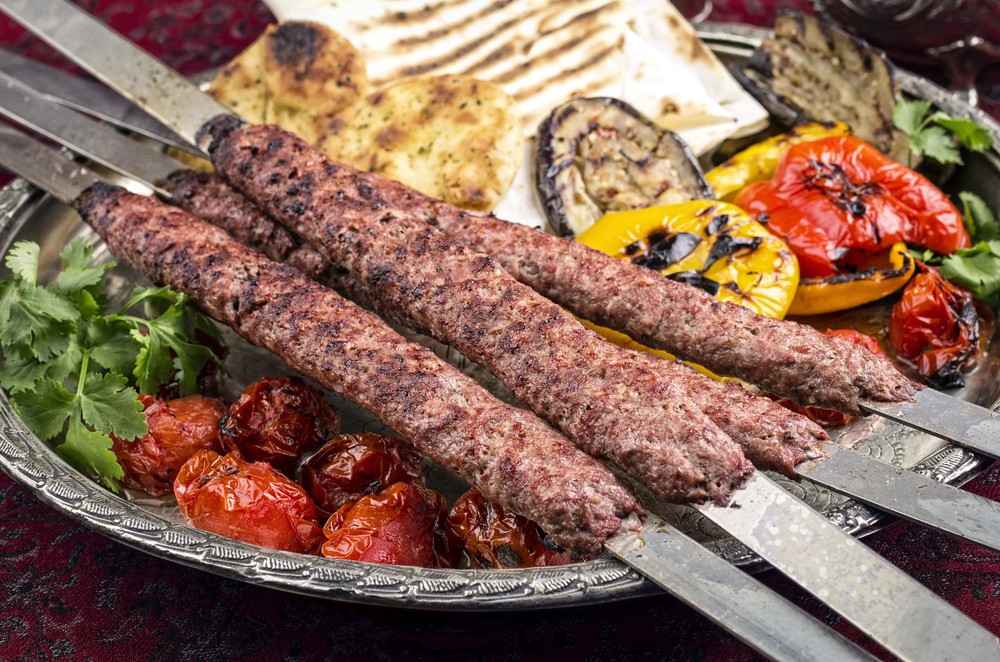
Kabab Koobideh or minced lamb kebab dates back to the reign of Naser al-Din Shah Qajar. This dish is one of the most famous and the most favourite kebabs amongst Persians and is considered to be Iran’s national dish. It can be served with Persian flat bread and grilled tomatoes and onions, or with buttered rice and grilled tomatoes and vegetables. One of the restaurants in Tehran that is famous for its Kabab Koobideh is called Nayeb and it has many branches in Tehran and other major cities in Iran.
Preparation time 15-30 mins
Cooking time: 30-60 mins
Total: 90-120 mins
Ingredients:
· 500 grs ground Lamb meat (۵۰۰ گرم گوشت چرخ کرده گوسفندی)
· 500 grs ground beef (۵۰۰ گرم گوشت گاو)
· 4 medium tomatoes (۴ عدد گوجه)
· 250 grs grated onions (۲۵۰ گرم پیاز رنده شده)
· ¼ cup steeped saffron (۱/۴ پیمانه زعفران دم کرده)
· Salt, pepper, sumac to taste (نمک و فلفل و سماق به میزان لازم)
First grate the onions and drain the water, reserving it for later. Grind the meat and mix them together. And finally add the onion, salt and pepper to the meat and mix it well for about 15 mins. Cover the meat and place it in the fridge for about 2 hours.
This dish is best when grilled over direct heat from firewood or charcoal. Use wide skewers and take a handful of the meet and evenly form it around the skewer. Place the kebabs over the fire taking care to constantly turn them to make sure they are cooked evenly. Cut the tomatoes and onions in half and place them on the grill.
This kebab is preferably served with saffron rice and butter. Mast o Mosir, or Mast o Khiar are best with kababs, as well as salad Shirazi and Sabzi Khordan.
Dizi or Abgoosht ()
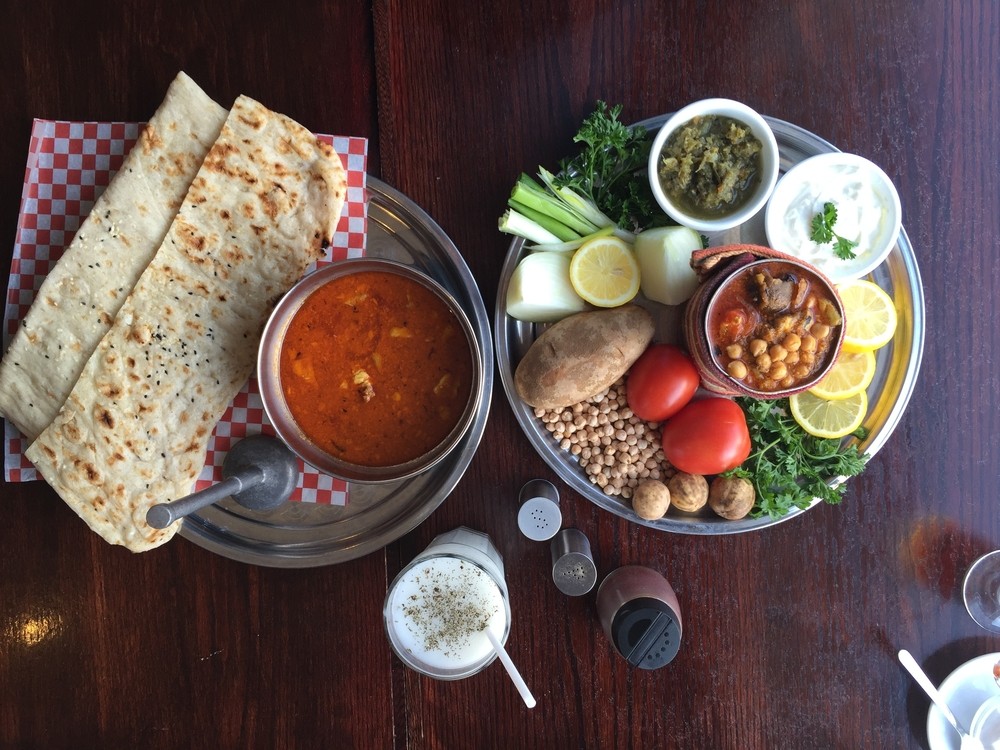
Dizi or Ab Goosht dates back to Safavid dynasty (early 16th century to 18th) in Iran. Dizi can be prepared differently in different cities but the most famous ones are cooked in clay pots (dizi), placed in wood burning oven, accompanied by freshly baked flat breads, lime and fresh herbs.
Preparation time: 10 mins
Cooking time: 2 hours
Total time: 2 hours 10 mins
Ingredients:
· 1 cup of chickpeas and white beans (۱ پیمانه نخود و لوبیا سفید)
· 500 grs lamb meat(۵۰۰ گرم گوشت گوسفند)
· 3 tomatoes (۳ عدد گوجه)
· 2 onions(دو عدد پیاز)
· 5 potatoes (۵ عدد سیب زمینی)
· 2 tsp tomato paste(۲ قاشق غذاخوری رب گوجه)
· 2 pcs green chillies (دو عدد فلفل سبز)
· 2 pcs dried lime(۲ عدد لیمو عمانی)
· 50 grs of fat(۵۰ گرم دنبه)
· Salt, black pepper and turmeric to taste(نمک، فلفل سیاه و زردچوبه به میزان لازم)
Soak the beans and chickpeas a night before. In a large clay pot, mix all the ingredients together and add 6 cups of water. Place the pot in a furnace or oven for two hours. Once cooked, separate the soup from the meat and other ingredients. Cut flat bread into small bite-sized pieces, place in a big bowl and pour the soup over the bread. Mash the meat, potatoes, tomatoes and the beans into a fine paste. This mashed meat is then served along with the mixture of bread. Freshly squeezed lime or lemon juice and some herbs makes this dish a delicious feast.
Ghorme Sabzi (قورمه سبزی) ‘Meat and Herb Stew’

Ghorme Sabzi is believed to be the king of all Persian food. It is not possible to find a Persian who does not enjoy having this dinner as a Friday lunch or at family gatherings and festivities. Ghorme Sabzi dates back to around 2000 years ago and like Fesenjaan, different cities have their own style of cooking. From the nutritional point-of-view, this food is a healthy meal as the ratio of herbs and legumes mixed with red meat is enough to cover the daily need of protein perfectly in our daily needs.
Preparation time: 60 min
Cooking time: 3 hours
Total time: 4 hours
Ingredients:
· 1 kg mixed herbs (scallion, parsley, coriander, small bunch of fenugreek)
(۱ کیلو سبزی مخلوط تره، گشنیز، جعفری، و مقدار کمی شنبلیله)
· 500 grs lamb meat(۵۰۰ گرم گوشت گوسفند)
· 1 large cup red kidney beans(۱ پیمانه بزرگ لوبیا قرمز)
· 4-5 pc dried lemon(۴-۵ غدد لیمو عمانی)
· 1 large onion(۱ عدد پیاز بزرگ)
· 2 cloves of garlic(۲ حبه سیر)
· Turmeric, salt and pepper to taste(نمک، فلفل و زرد چوبه به میزان لازم)
First: soak the red kidney beans from the night before and change the water a few times. Fry the chopped onion and garlics until golden and add some turmeric to it. Cut the meat into small pieces and add to the onions and fry for about 10 minutes. Cook the red kidney beans in a different pan. Chop the herbs finely and add to the meat, add salt and pepper and fry everything for 20 more minutes. Pour 4 cups of water, add the dried lemons, turn the heat down, and let the Ghorme simmer for about 2 hours. Ghorme Sabzi is served with rice, salad and pickles.
Ashe Reshteh (آش رشته)
Ash Reshteh is a dish perfect for cold winters. It is a healthy dish, containing a range of legumes and herbs. It is believed that over 200 different kinds of Ash are cooked around Iran but Ash Reshteh is the most famous one amongst them and very nutritious.
Preparation time: 60 mins
Cooking time: 2 hours
Total time: 3 hours
Ingredients:
· 1 cup chickpeas(۱ پیمانه نخود)
· 1 cup red kidney beans(۱ پیمانه لوبیا قرمز)
· 1 cup lentils (۱ پیمانه عدس سبز)
· ¼ rolled barley(۱/۴ پیمانه پرک جو)
· 3 onions (۳ عدد پیاز)
· 1 tbs turmeric(۱ قاشق غذاخوری زردچوبه)
· 1 cup chopped spinach (۱ پیمانه اسفناج خرد شده)
· 1 cup chopped parsley(۱ پیمانه جعفری خرد شده)
· 1 cup chopped coriander(۱ پیمانه گشنیز خرد شده)
· 1 cup chopped dill(۱ پیمانه شوید خرد شده)
· 1 cup chopped scallion(۱ پیمانه تره خرد شده)
· 4 tbs dried mint(۴ قاشق غذاخوری نعناع خشک)
· 100 grams of Persian Reshteh ‘spaghetti’(۱۰۰ گرم رشته آش)
· 4 cloves of garlic, chopped(۴ حبه سیر نگینی)
· Salt and pepper to taste (نمک و فلفل به میزان لازم)
· 4 tbs vegetable oil(۴ عدد روغن نباتی)
First soak the legumes a night before, changing the water a few times. Fill a big pot with 6 large cups of water and bring to boil. Drain the legumes and add to the boiling water. Turn the heat low and let it simmer for about an hour or until cooked. After the beans are cooked add all the mixed herbs and let it simmer of one more hour on low heat. And finally add the Persian reshteh and let it cook for about half an hour.
In a frying pan, fry half of chopped onion and garlic, add the half of turmeric and salt and pepper until golden brown, add 2 tbs of dried mint and mix the dried onion with the Ash. In the same frying pan, fry the rest of onion and garlic with turmeric and the rest of mint until golden brown and crunchy. This is used for decorating the Ash when served. Ash Reshteh is either served with vinegar or Persian kashk, ‘thick curd’ and flat bread.
Tah Chin Morgh (ته چین مرغ) ‘Chicken and saffron rice’
Tah chin morgh is another favourite dish in Iran. It can be cooked with chicken or beef but the chicken version is more appreciated. It is a kind of dish that is cooked for special occasions as well as family gatherings, wedding ceremonies and during festivities. There is a funny story behind the invention of Tah chin. It is believed a court cook “we don’t know which court and which king”, makes a mistake while cooking the rice so it becomes very soft and inedible according to Persian taste. The cook worried for his job and safety, clever enough, mixes the very soft rice with some yolk eggs, yogurt and saffron, chicken in layers, and cooks the mixture for another hour. When it comes to serving the dish, he presented it as something like a meat pie, although in taste it is entirely different from the western pie.
Preparation time: 30 mins
Cooking time: 90 mins
Total time: 2 hours
Ingredients:
1 kg chicken breast(۱ کیلو سینه مرغ)
3 cups of rice(۳ پیمانه برنج)
100 gr butter (۱۰۰ گرم کره)
1 onion(۱ عدد پیاز)
2 cloves of garlic(۲ حبه سیر)
100 gr barberry(۱۰۰ گرم زرشک)
1 cup steeped saffron(۱ پیمانه زعفران دم کرده)
1 cup Greek yogurt(۱ پیمانه ماست چکیده)
Sliced pistachios to taste(خلال پسته به میزان لازم)
Salt, pepper and turmeric to taste(نمک،فلفل و زردچوبه به میزان لازم)
First cook the chicken breast with onion, garlic and spices for about 45 mins. When cooked removeand shred the chicken and set aside. Cook the rice in 6 cups of boiling water for about 15 mins, drain and put aside.
Mix the egg yolk, saffron, Greek yogurt, with the shredded chicken. Cover the cake pan with butter and add rice and the mixture of chicken in layers, making sure the last layer is rice. Cover the cake pan with a pot lid, and put on low heat to cook for around an hour. It can be also placed in an oven. When ready, turn the rice in a large serving plate, decorate it with fried barberries and some pistachios.
Kale Pache
Although Kale Pache is considered to be a very heavy food, it is mostly consumed as a breakfast during the weekend and almost always in the winter. The appearance of this food is not very appetizing but most people who have tried it agree that it was tasty and once must experience it at least once in their lifetime.
Preparation time: 15 mins
Cooking time: 3 hours
Total time: 3:15 mins
Ingredients:
· 1 lamb head(۱ عدد کله گوسفند)
· 4 extra lamb tongues(۴ عدد زبان گوسفند اضافه)
· 4 lamb hooves(۴ عدد پاچه)
· 4 onions(۴ عدد پیاز)
· 5 cloves of garlic(۵ حبه سیر)
· 1 tbs of turmeric(۱ قاشق غذاخوری زردچوبه)
· 1 inch of fresh ginger(۳ سانت زنجبیل تازه)
· 1 stick of cinnamon (۱ چوب دارچین)
· Salt and pepper to taste (نمک و فلفل به میزان لازم)
Make sure to buy the ingredients from a trusted butcher, so it is clean and fresh. Thoroughly wash the meat and put in a pan, add water until it covers the head. Add chopped onion, garlic and ginger, along with salt, pepper, turmeric and cinnamon. Put on high heat to bring it to a boil, and then turn the heat down and let simmer for 3 hours. By the time it is cooked, the water should be halved. Kale Pache is served with freshly baked Persian flat bread, lemon, and sabzi khordan.
Ghali-e Mahi (قلیه ماهی) ‘Steamed Persian rice with Fish stew’
Moving to the south of Iran, Ghali-e Mahi is the most famous food of the Khozestan county. The perfect Ghali-e is cooked by fishermen using hamour fish which is a type of reef grouper, however, any genuine Khozestani knows how to cook a Ghali-e perfectly. One of the secrets of a good Ghali-e Mahi is that the fish should be from salty waters of southern seas like the Persian Gulf or the Karoon river, which has salty water. This dish can also be cooked with shrimps and in this version it has more fans than any other stew in the south of Iran. However, it is a common belief that people from the north of Iran are not in favour of this dish, probably because of spices and the sharp sour taste that it has.
Preparation time: 30-60 mins
Cooking time: 2 hours
Total time: 3 hours
Ingredients:
· 1 kg hamour fish, cut into large pieces (۱ کیلو ماهی هامور تکه شده)
· 250 grs chopped coriander(۲۵۰ گرم گشنیز خرد شده)
· 50 grs of chopped fenugreek(۵۰ گرم شنبلیله خرد شده)
· 2 head of garlic(۲ کله سیر)
· 6 onion(۶ عدد پیاز)
· 250 grs tamarind(۲۵۰ گرم تمبر هندی)
· 1 tbs turmeric(۱ قاشق غذا خوری زردچوبه)
· 1 tbs flour(۱ قاشق غذاخوری آرد)
· 3 tbs tomato paste(۳ قاشق غذا خوری رب گوجه )
· Salt, pepper, chili to taste(نمک ، فلفل سیاه و فلفل قرمز به میزان لازم)
First wash and clean the fish and set aside. Chop the herbs finely and set aside. Grind the onions and the garlic in a pan and add oil, cook until golden brown. Add salt, pepper, chili and turmeric and cook for 2-3 mins. Add tomato paste and flour while frying for another 5 mins. Add the chopped herbs and fry until it changes colour and become dark green.
Mix the tamarind with 3 cups of water and drain it thoroughly. Pour the tamarind into the pan and turn the heat up to make to boil. Once it is boiling, add the pieces of fish to the pan, turn the heat down and let simmer for around 2 hours. Make sure not to stir the Ghali-e that often as it will break the fish into flakes. When ready, serve with rice, Sabzi khordan and pickles.
Khorsh Bamie (خورش بامیه) ‘Persian steamed rice with Okra stew’
Another famous southern dish in Iran is Okra stew or Khorsh Bamie. This Khoresh is famous for the marvellous harmony of meat, chickpeas, Okra and tomatoes. Very easy to cook, the Okra in this Khoresh is considered to be a detoxicating food in Persian cuisine. The Arabic version of this Khoresh is cooked almost the same but it is much more spicy and not everyone can eat it.
Preparation time: 15 mins
Cooking time: 2 hours
Total time: 2:15 mins
Ingredients:
· 500 gr lamb meat(۵۰۰ گرم گوشت گوسفند)
· 500 gr Okra(۵۰۰ گرم بامیه)
· 2 onion, chopped(۲ عدد پیاز نگینی)
· 4 cloves of garlic, chopped(۴ حبه سیر نگینی)
· 6 ripe tomatoes, grated(۶ گوجه رسیده رنده شده)
· 1 tbs tomato paste(۱ قاشق غذا خوری رب گوجه فرنگی)
· Salt, pepper, turmeric and chili to taste (نمک،فلفل سیاه،زرد چوبه و فلفل قرمز به میزان لازم)
· 3 cups of boiling water(۳ پیمانه آب جوش)
· Some freshly squeezed lemon juice(مقداری آب لیموی تازه)
In a pan, fry the chopped onions and garlic until golden brown. Add the meat and fry for 15 minutes. Add salt, pepper, turmeric and chili and fry for 5 more minutes. Add grated tomatoes along with the tomato paste and fry for 15 more minutes. Add 3 cups of boiling water and cover the pan, let simmer on low hit for around 1 hour. At this point add the okra and let simmer for 15 minutes or until cooked. At the end the Khoresh should have around half the water. Turn off the stove and add freshly squeezed lime juice, mixing well. Serve with saffron rice, salad and sabzi khordan.
Baghali Polo ba Mahiche (باقالی پلو با ماهیچه) ‘Broad bean rice with lamb shanks’
This dish is also one of the famous dishes, normally served at weddings, gatherings and during festivities. In the south of Iran, Baghali Polo is made but instead of lamb shanks they used deep fried fresh fish, which makes it as tasty as when it is served with shanks.
Preparation time: 30 mins
Cooking time: 90 to 120 mins
Total time: 2 hours and 30 mins
Ingredients:
· 3 potatoes, sliced(۳ عدد سیب زمینی ورقه شده)
· 2 onions, chopped(۲ عدد پیاز نگینی)
· 4 cups of Jasmin rice(۴ پیمانه برنج معطر ایرانی)
· 2 cups of broad beans(۲ پیمانه باقالی تازه)
· 1 kg of lamb shanks(۱ کیلو ماهیچه گوسفندی)
· 1 cup dried dill(۱ پیمانه شوید خشک)
· 100 gr butter(۱۰۰ گرم کره)
· ¼ cup steeped saffron(۱/۴ پیمانه زعفران دم کرده)
· Salt, pepper and turmeric to taste(نمک، فلفل و زردچوبه به میزان لازم)
For the rice:
First clean and separate the beans, wash and set aside. In a large pot pour 8 cups of water, add some salt and bring to boil. Add the rice and broad beans to the boiling water and cook for 10 mins. Add the dried dill to the rice and cook for 2 more mins, then drain. Add some oil and half the butter in the pan, place the potatoes at the base of the pan and then pour the rice and broad beans, cover and let it steam for around half an hour or until cooked.
For the shanks:
In another pan, mix the shanks, onion, garlic, all the spices and 3 cups of water. Place on high heat until it starts to boil, turn the heat down and let it simmer for an hour or until cooked. Serve the rice and the cooked meat in different serving dishes, accompanied by Mast o khiar, salad, and sabzi khordan.
Desserts
Just like Persian food, desserts too vary in different cities in Iran. Halva(حلوا) is famous in almost every Persian city, while Ranginak (رنگینک) is specially made in the south of Iran and is a healthy dessert based on the ingredients containing it. In what follows, these two desserts and their recipes are introduced here.
Saffron Halva (حلوا زعفرانی)
This dessert is one of the most renowned desserts in Iran. It is mainly cooked for festivities, gatherings, or in the holy month of Ramadan. It is also sometimes prepared on the last day of funeral as a sign of well wishes and good health for everyone who has attended the ceremony.
Preparation time: 10 mins
Cooking time: 30-45
Total time: 1 hour
Ingredients:
· 2 cups wheat flour(۲ پیمانه آرد گندم)
· 1 ½ cups ghee or clarified butter (۱ پیمانه و نیم روغن حیوانی یا کره)
· 2 ½ cups water(دو پیمانه و نیم آب)
· 1 ½ cups sugar(۱ پیمانه و نیم شکر)
· ¼ cups rose water(۱/۴ پیمانه گلاب)
· ¼ cup steeped saffron(۱/۴ پیمانه زعفران دم کرده)
It is best to prepare the syrup first by mixing the water and sugar and boiling it until the sugar has dissolved. Turn the heat down and let it simmer for 5 mins and add the saffron and the rose water.
In a big pan, fry the wheat flour in the clarified butter for 10 minutes or until the colour turns a light brown. Add the syrup gradually to the flour mixture while mixing constantly. Stir the halva if it is too watery, if not, serve on a plate and decorate with cinnamon and pistachios slivers.
Ranginak
Ranginak is a dessert specially made in the southern cities of Iran. It is nutritious and healthy.
Preparation time: 60 mins
Cooking time: 30 mins
Total time: 90 mins
Ingredients:
· 2 cups flour(۲ پیمانه آرد)
· 200 gr butter(۲۰۰ گرم کره)
· 1 tbsp cinnamon(۱ قاشق غذاخوری پودر دارچین)
· 1 tbsp cardamom (۱ قاشق غذاخوری پودر هل)
· 200 gr walnut(۲۰۰ گرم گردو)
· 400 gr dates(۴۰۰ گرم خرما)
Takes out the seeds of the dates and fill them with a generous piece of walnut. Arrange the dates in a concentric circle in a serving dish. Heat the butter and add the flour, cinnamon and cardamom and fry the mixture for about 20 minutes or until golden brown. Pour the mixture over the dates and decorate with cinnamon and pistachios. This is best served with black tea or Turkish coffee.
This article has looked into different starters, main dishes and famous desserts of Persian cuisines. Persians are a very welcoming and warm people when it comes to hosting guests and food is the best way to show their affections. Young women are always encouraged to learn how to cook before getting married while there are men who are professional yet unknown chefs who cook like a trained person. Persians like other cultures celebrate different occasions by gathering together and preparing meals that are favourites of every Iranian. Kabab Koobideh, Ghorme Shabzi, Tah Chin Morgh and Fesenjoon are instances of these dishes that are served in parties and weddings alike.

